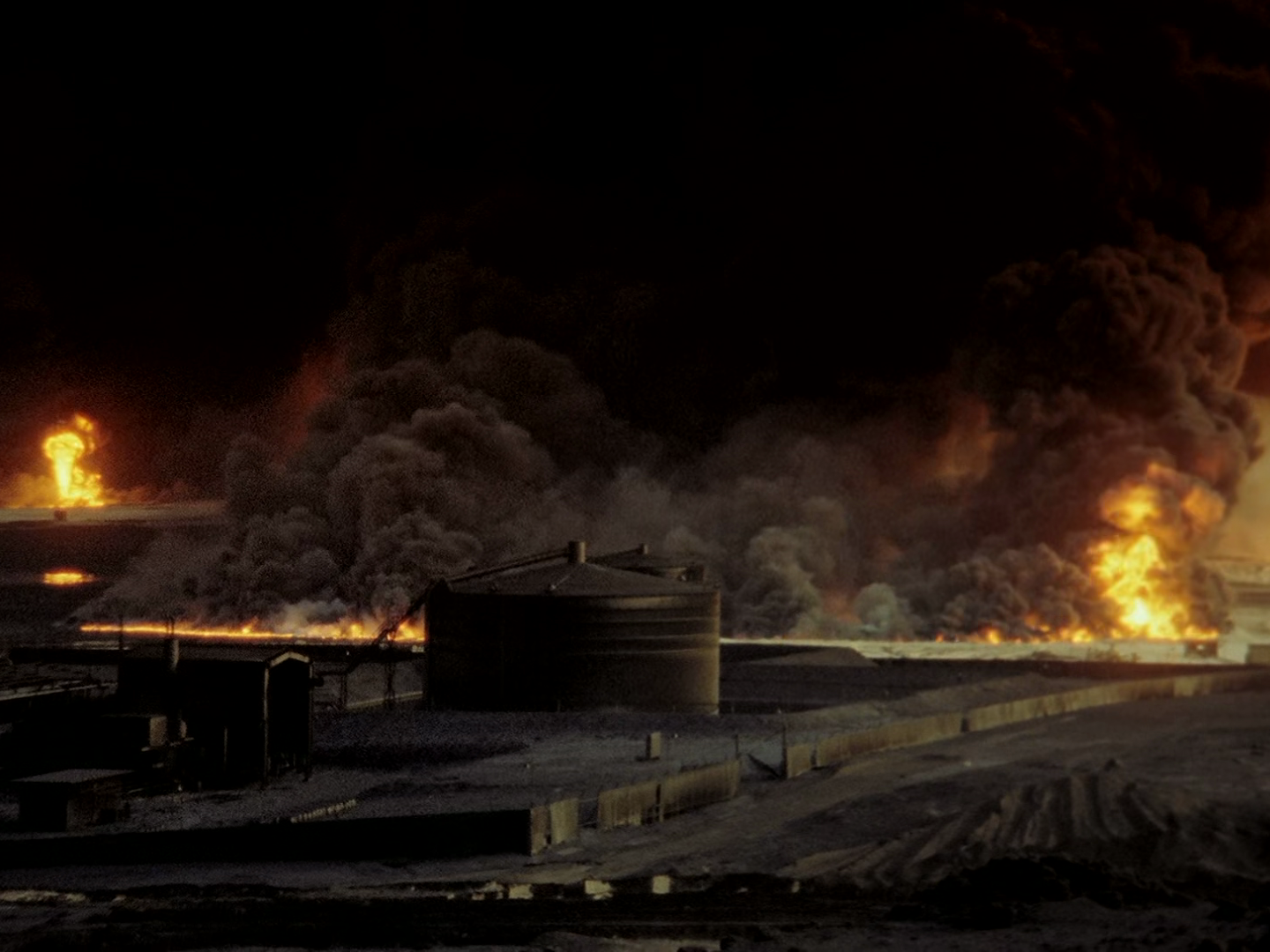
Shortly after the Gulf War, oil fires were raging all through Kuwait. In the week before this sea of fire would be extinguished, Werner Herzog filmed this apocalyptic landscape with its murky skies, scorched earth and capricious flames.
EN
“The collapse of the stellar universe will occur – like creation – in grandiose splendor."
“In white letters sharply defined against a black screen, Blaise Pascal’s famous quote fittingly opens Lessons of Darkness (1992), Werner Herzog’s spectacular documentary about ecological disaster and the Gulf War. I say fittingly because the quote is fake (it was fabricated by Herzog to direct his audience to engage on a very “high level” before the movie even properly begins) and because Lessons of Darkness, for all its profundity, isn’t exactly a true documentary, either. It is, however, exemplary of Herzog's nonfiction style.
[...] What has developed as one of the most consistently unique aspects of Herzog’s style is the friction that occurs when the viewer senses clashing between fictive elements that are awkwardly laminated atop apparent truths; a fit the viewer perceives as tangibly if ineffably not-quite-right. L.M. Kit Carson described Dennis Hopper’s The Last Movie (1971) as “driving spikes into ordinary moments to crack them.” Herzog also intentionally crazes his films in a way that invites the viewer to marvel at and be baffled by how brazenly disparate their surfaces are from what lies beneath. When Herzog “cast” the burning oilfields of Kuwait to play-act the role of a sci-fi apocalypse in Lessons of Darkness, no viewer was expected to believe it as such given its historical significance, but the overlaid fiction paradoxically elicits the response, “How could this insanity be Earth?” Peter Jackson’s doomsday computer generated imaginings of Mordor pale in comparison.”
Ben Simington1
“There is not a single frame in Lessons of Darkness in which you can recognize our planet; for this reason the film is labeled ‘science fiction,’ as if it could only have been shot in a distant galaxy, hostile to life. At its premiere at the Berlin Film Festival, the film met with an orgy of hate. From the raging cries of the public I could make out only ‘aestheticization of horror.’ And when I found myself being threatened and spat at on the podium, I hit upon only a single, banal response. ‘You cretins,’ I said, ‘that’s what Dante did in his Inferno, it’s what Goya did, and Hieronymus Bosch too.’”
Werner Herzog2
“Calling Lessons of Darkness a science fiction film is a way of explaining that the film has not a single frame that can be recognised as our planet, and yet we know it must have been shot here. I spoke earlier of our ‘embarrassed landscapes’. Well, the landscape you see in Lessons of Darkness is not just embarrassed, it is completely mutilated. The film plays out as if the entire planet is burning away, and because there is music throughout the film, I call it ‘a requiem for an uninhabitable planet’. Unlike La Soufrière, which tries to document a natural catastrophe, Lessons of Darkness is a requiem for a planet that we ourselves have destroyed.”
Paul Cronin, Werner Herzog3
“The pace of the film is slow, and it is perhaps in this way that it enacts a critique of how wars have been reported on cable television. CNN comes up frequently in discussions of this film, partly because it established its reputation by covering this war, and partly because Herzog borrows some of CNN’s footage in order to depict the war itself. In ‘Part II: A War’, we do not see the war transpire, but we see it as framed or depicted – in a mediated way – by television news. Neither are Herzog’s images the destruction of war in itself; his images too are framed and mediated. Herzog does not admit any continuity between his compositions and CNN’s, asserting: ‘The stylisation of the horror in Lessons of Darkness means that the images penetrate deeper than the CNN footage ever could, something that bothered audiences in Germany a great deal.’ If there is a difference, it comes from the slow, stylised presentation of the images – that they unfold over a prolonged period. It is the difference that comes of holding our gaze in one place, encouraging us to survey the images (and, presumably, admit that these too are ‘landscapes of the mind’), and our exposure to bits and bites of war on cable television. Nadia Bozak expresses it this way: ‘[Herzog] refuses the ‘live’ frenzy of Gulf War I, the crisis told in the ticker-tape escapades of the network’s real-time broadcasts. Though Herzog’s film was an immediate response to CNN’s images of ‘Desert Storm’ and a reaction to their instantaneous, spontaneous liveness, Herzog does not allow this same urgency to penetrate the fabric of his film’ (2006: 24).”
Brad Prager4
- 1Ben Simington, "Herzog: Ecstatic Truths - A Werner Herzog Documentary Retrospective," MUBI Notebook, 31 March 2016.
- 2Werner Herzog, "On the Absolute, the Sublime, and Ecstatic Truth," Arion 17, nr. 3, 2010, 1-12. Translated by Moira Weigel.
- 3Paul Cronin, Werner Herzog, Werner Herzog: A Guide for the Perplexed, (Faber & Faber, 2002), 249.
- 4Brad Prager, The Cinema of Werner Herzog: Aesthetic Ecstasy and Truth, (New York: Columbia University Press, 2007), 355-356.

